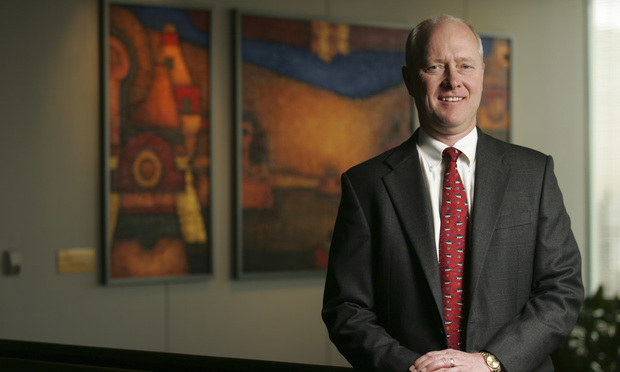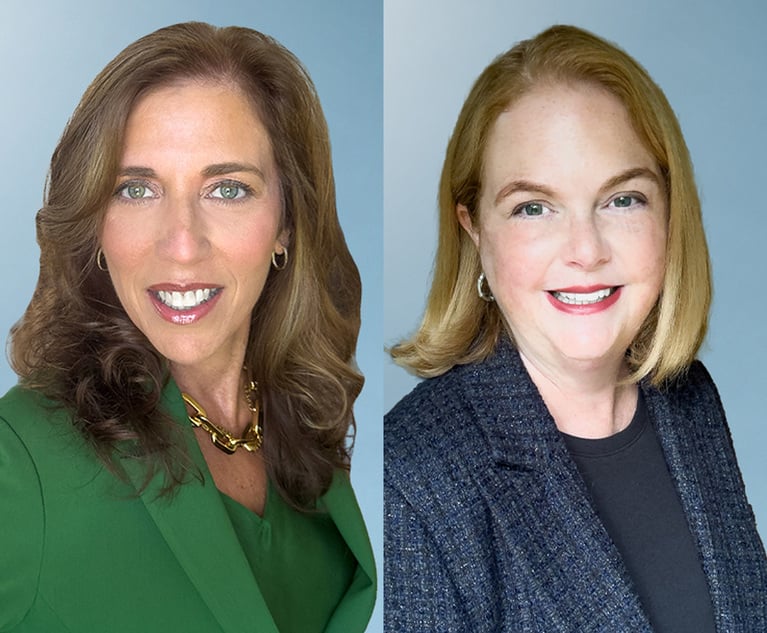The 200-Partner Tour: California Firms Reduce Lateral Risk The Old-Fashioned Way
While many in the industry are seeking a "Moneyball" approach to lateral hiring, Sheppard Mullin and Munger Tolles rely on intensive face-to-face meetings to mitigate the risk of bringing on new partners.
January 28, 2018 at 06:00 PM
9 minute read
 Guy Halgren, Sheppard Mullin
Guy Halgren, Sheppard MullinIf you have a billable hour (or dozens) to spare, an old-school approach to lateral hiring is showing it has staying power as some law firms are proving successful by investing in pre-hire face time. But for those firms that can't stomach repeating the interview process upward of 200 times, data analytics is starting to creep into the hiring process, too.
When Sheppard, Mullin, Richter & Hampton nears the end of the process for hiring a new lateral partner, candidates typically endure what firm chairman Guy Halgren dubs “The Tour”: a trip to almost all of the firm's domestic offices, plus video conferences, to meet a large swath of its partnership.
“By the time they've gone through the whole process, including the tour, they often say they know more about our firm than the firm they're coming from,” Halgren says.
The endeavor, Halgren says, brings several benefits to the firm, ensuring that partners have a chance to meet the prospective candidate before a partnership-wide vote on whether to bring the person on board—something that happens for all laterals. All those meetings also help Sheppard Mullin spot potential red flags, such as a sharp-elbowed personality or a siloed practice that doesn't offer as many synergies as the firm would hope. The idea, from the firm's perspective, is to give each candidate a very close look to determine their potential fit from both a cultural and business perspective.
“We have a very strict no jerks rule around the firm,” Halgren says. “We do not bring in laterals just because they have a book of business if they're not straightforward, honest people.”
Beyond the vetting and extensive meetings with the partnership, Halgren considers other factors key to its lateral hiring process. Either he, vice chairman Jon Newby or managing partner Robert Beall personally lead every recruiting effort, he says. That imposes a measure of accountability for every hire that goes up to the top levels of the firm's management.
“Every recruit we bring in, we are putting our reputation on the line,” Halgren says, referring to Newby, Beall and himself. “That's different than a lot of firms, where there's no one person that's responsible, but rather the candidate just shows up one day.”
Meanwhile for the potential lateral, who may meet with some 200 partners, the tour is part of a process in which Sheppard Mullin discloses “a tremendous amount of information about our firm,” ranging from the partnership agreement to financial performance to management and in-house diversity initiatives. The upsides carry over once lateral partners start and begin to integrate, since they'll have met with a wide array of people in different parts of the firm, Halgren says.
In many respects, Sheppard Mullin's approach to hiring laterals is a tried-and-true one, based on interpersonal evaluations and widespread consensus, even at a time when there has been a documented push by some in the industry to inject more data and market research into the process. And for the most part, it has worked. Halgren estimates that the firm has retained 70 percent of the laterals hired since he stepped into his leadership role in 2001 and started keeping track. If those estimates are accurate, Sheppard Mullin would be well above the legal industry's average success rate for lateral partner hires. Recent studies have shown that as many as 50 percent of laterals fail—meaning they're gone from the new firm within five years.
Other firms have emphasized pre-hiring relationship building as well, such as Munger, Tolles & Olson. Lateral hiring isn't something the firm takes lightly or does often, so there was a lot on the line when it considered opening in Washington, D.C., in 2016. The new location became the firm's first outpost beyond California's borders and was a rare instance of its hiring laterally in any form. Michael DeSanctis, who formed the new office alongside former U.S. Solicitor General Donald Verrilli, describes the recruiting effort that landed them at Munger in terms that echo Sheppard Mullins' approach.
Before DeSanctis and Verrilli joined Munger, they visited the firm's home office in Los Angeles and its only other outpost at the time, in San Francisco. Adding new lawyers across the country added a level of intensity to the decision-making. In the visits to the California outposts, DeSanctis says he met with roughly 100 lawyers—about half of the firm—ranging from the most senior partners down to midlevel partners and associates. The process, he says, helped put his and Verrilli's minds at ease that they would have a place to thrive at Munger.
“It was a tremendous amount of time, a tremendous amount of otherwise billable hours. I think that shows how seriously Munger takes it,” DeSanctis says. “Because they hire laterals so rarely, they really want to make it work.” Since its launch, the Washington office has now grown to 12 lawyers.
Facetime vs. Data
The experience of Sheppard Mullin and Munger Tolles suggest that one key to successful lateral hiring is the adoption of techniques that have long been around. At the same time, Big Law as a whole has persistently struggled with successfully hiring laterals. Recognizing those shortfalls, there are businesses, such as human resources and business intelligence provider Decipher Global or software provider Aderant, aiming to support law firms that want to make their forays into the lateral market more reliant on data and market intelligence.
Decipher, for its part, offers to serve in an independent vetting role for law firms considering new lateral hires, creating in-depth and confidential due diligence reports based on interviews within the relevant legal market. Decipher's approach is to help a law firm determine how a candidate is viewed in the marketplace and what the lawyer's clients think of him or her.
Another player is Aderant, a legal software company that offers a variety of time, billing and other products for law firms. One of Aderant's products, Spotlight Analytics, has applications that firms could use to enhance their lateral hiring efforts, says Derek Schutz, the company's product manager for business intelligence.
Schutz says that while qualitative factors—such as a person's fit within a particular firm's culture—are critical to successful lateral hiring efforts, there are also opportunities to use data in a “score-carding” method. As a starting point, firms can run analyses of their recent lateral hires to determine how their billable hours, origination credits and other business metrics stacked up against what the firm had hoped or expected for those laterals.
Schutz discusses a model that's akin to a sort of “Moneyball” approach, a reference to the famed Michael Lewis book documenting the rise of “sabermetrics” in evaluating professional baseball players and using statistics to help create effective teams. By looking at past performance data to see how laterals did when they came on board, and how that performance changed over time, firms can use data to create a profile of what they're looking for in an incoming candidate, he says. From there, a firm could try to find a candidate who closely fits the profile that their model suggests.
“Before we even look at an individual, it's important to understand what the firm does well, what they don't do well and what reasons are for a lateral hire,” Schutz says. “Then they can estimate or move forward, and say based on this, this is what we've seen happen in the past … here's the type of individual we had in the past, these were the ones that worked, these were the ones who didn't.”
It's unclear, however, how widely law firms have adopted something close to the data-centric model that Schutz describes. Schutz says he knows of at least a handful of firms who have moved in that direction, though he declined to give any names.
Regardless of whether a firm uses a data-driven or more traditional, interpersonal approach, they're often trying to evaluate the same set of factors and to avoid partners who aren't going to fit within the new firm, either because of a cultural mismatch or an incompatible law practice.
Sheppard Mullin's Halgren points to particular warning signs that might steer Sheppard Mullin away from a candidate, including multiple stops at different law firms over a relatively short period of time.
“We seldom will hire a peripatetic partner who moves from firm to firm to firm. … It's highly unlikely that the person will be satisfied with us,” Halgren says. “Another lesson is that you don't typically change people when they're adults.”
Speaking about lateral hiring generally, legal recruiter Harrison Barnes of BCG Attorney Search mentions similar red flags. Seeing a candidate with more than three law firm stops in 15 years could be a sign that “things aren't going to work wherever” that person goes, he says. Instead, the best candidates are those who have a stable employment record.
“There are just certain people in the market that would go to a firm and they'd be the last person standing,” Barnes says. “Those are the ones you want.”
He adds that firms should look out for candidates pushing for a guaranteed contract because it may indicate shortcomings in the true book of business that the lateral has. In those instances, firms can protect themselves by avoiding a guaranteed contract and, instead, linking an incoming partner's pay closely to their performance as a business generator.
“The best firms tend to take it very slowly; most firms will ask for at least three years of origination credit to understand the attorney's business better,” Barnes says. “The more they tie the person's compensation to their performance the better off they'll be.”
This content has been archived. It is available through our partners, LexisNexis® and Bloomberg Law.
To view this content, please continue to their sites.
Not a Lexis Subscriber?
Subscribe Now
Not a Bloomberg Law Subscriber?
Subscribe Now
NOT FOR REPRINT
© 2025 ALM Global, LLC, All Rights Reserved. Request academic re-use from www.copyright.com. All other uses, submit a request to [email protected]. For more information visit Asset & Logo Licensing.
You Might Like
View All
Once the LA Fires Are Extinguished, Expect the Litigation to Unfold for Years
5 minute read

Faegre Drinker Adds Three Former Federal Prosecutors From Greenberg Traurig
4 minute readTrending Stories
Who Got The Work
J. Brugh Lower of Gibbons has entered an appearance for industrial equipment supplier Devco Corporation in a pending trademark infringement lawsuit. The suit, accusing the defendant of selling knock-off Graco products, was filed Dec. 18 in New Jersey District Court by Rivkin Radler on behalf of Graco Inc. and Graco Minnesota. The case, assigned to U.S. District Judge Zahid N. Quraishi, is 3:24-cv-11294, Graco Inc. et al v. Devco Corporation.
Who Got The Work
Rebecca Maller-Stein and Kent A. Yalowitz of Arnold & Porter Kaye Scholer have entered their appearances for Hanaco Venture Capital and its executives, Lior Prosor and David Frankel, in a pending securities lawsuit. The action, filed on Dec. 24 in New York Southern District Court by Zell, Aron & Co. on behalf of Goldeneye Advisors, accuses the defendants of negligently and fraudulently managing the plaintiff's $1 million investment. The case, assigned to U.S. District Judge Vernon S. Broderick, is 1:24-cv-09918, Goldeneye Advisors, LLC v. Hanaco Venture Capital, Ltd. et al.
Who Got The Work
Attorneys from A&O Shearman has stepped in as defense counsel for Toronto-Dominion Bank and other defendants in a pending securities class action. The suit, filed Dec. 11 in New York Southern District Court by Bleichmar Fonti & Auld, accuses the defendants of concealing the bank's 'pervasive' deficiencies in regards to its compliance with the Bank Secrecy Act and the quality of its anti-money laundering controls. The case, assigned to U.S. District Judge Arun Subramanian, is 1:24-cv-09445, Gonzalez v. The Toronto-Dominion Bank et al.
Who Got The Work
Crown Castle International, a Pennsylvania company providing shared communications infrastructure, has turned to Luke D. Wolf of Gordon Rees Scully Mansukhani to fend off a pending breach-of-contract lawsuit. The court action, filed Nov. 25 in Michigan Eastern District Court by Hooper Hathaway PC on behalf of The Town Residences LLC, accuses Crown Castle of failing to transfer approximately $30,000 in utility payments from T-Mobile in breach of a roof-top lease and assignment agreement. The case, assigned to U.S. District Judge Susan K. Declercq, is 2:24-cv-13131, The Town Residences LLC v. T-Mobile US, Inc. et al.
Who Got The Work
Wilfred P. Coronato and Daniel M. Schwartz of McCarter & English have stepped in as defense counsel to Electrolux Home Products Inc. in a pending product liability lawsuit. The court action, filed Nov. 26 in New York Eastern District Court by Poulos Lopiccolo PC and Nagel Rice LLP on behalf of David Stern, alleges that the defendant's refrigerators’ drawers and shelving repeatedly break and fall apart within months after purchase. The case, assigned to U.S. District Judge Joan M. Azrack, is 2:24-cv-08204, Stern v. Electrolux Home Products, Inc.
Featured Firms
Law Offices of Gary Martin Hays & Associates, P.C.
(470) 294-1674
Law Offices of Mark E. Salomone
(857) 444-6468
Smith & Hassler
(713) 739-1250







